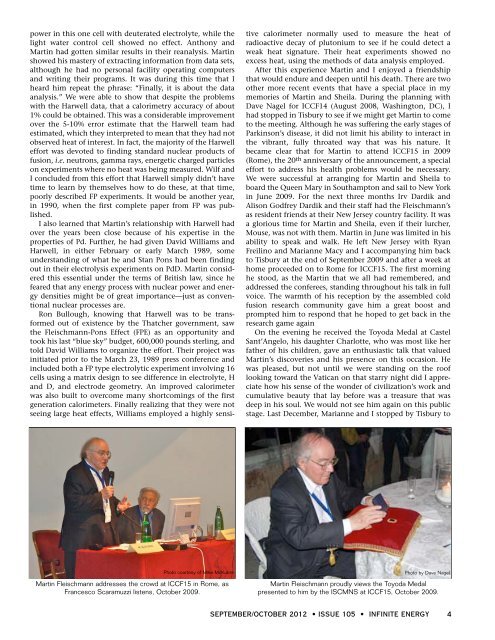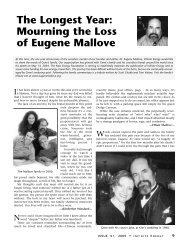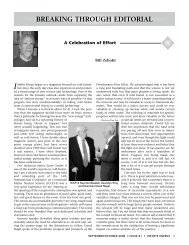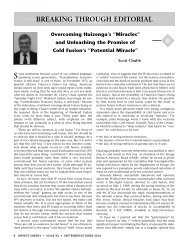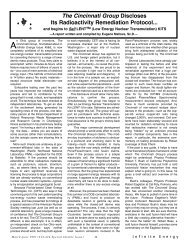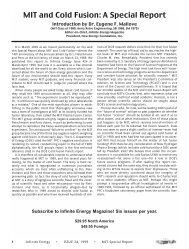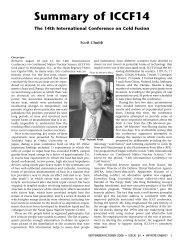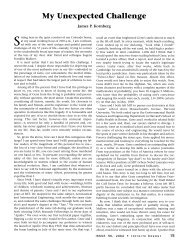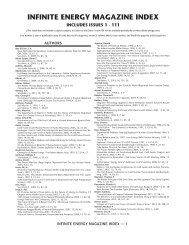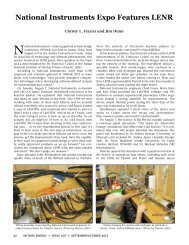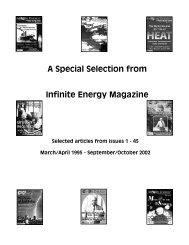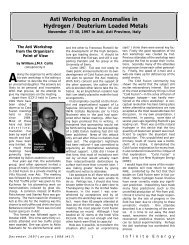Martin Fleischmann's Historic Impact - Infinite Energy Magazine
Martin Fleischmann's Historic Impact - Infinite Energy Magazine
Martin Fleischmann's Historic Impact - Infinite Energy Magazine
Create successful ePaper yourself
Turn your PDF publications into a flip-book with our unique Google optimized e-Paper software.
power in this one cell with deuterated electrolyte, while the<br />
light water control cell showed no effect. Anthony and<br />
<strong>Martin</strong> had gotten similar results in their reanalysis. <strong>Martin</strong><br />
showed his mastery of extracting information from data sets,<br />
although he had no personal facility operating computers<br />
and writing their programs. It was during this time that I<br />
heard him repeat the phrase: “Finally, it is about the data<br />
analysis.” We were able to show that despite the problems<br />
with the Harwell data, that a calorimetry accuracy of about<br />
1% could be obtained. This was a considerable improvement<br />
over the 5-10% error estimate that the Harwell team had<br />
estimated, which they interpreted to mean that they had not<br />
observed heat of interest. In fact, the majority of the Harwell<br />
effort was devoted to finding standard nuclear products of<br />
fusion, i.e. neutrons, gamma rays, energetic charged particles<br />
on experiments where no heat was being measured. Wilf and<br />
I concluded from this effort that Harwell simply didn’t have<br />
time to learn by themselves how to do these, at that time,<br />
poorly described FP experiments. It would be another year,<br />
in 1990, when the first complete paper from FP was published.<br />
I also learned that <strong>Martin</strong>’s relationship with Harwell had<br />
over the years been close because of his expertise in the<br />
properties of Pd. Further, he had given David Williams and<br />
Harwell, in either February or early March 1989, some<br />
understanding of what he and Stan Pons had been finding<br />
out in their electrolysis experiments on PdD. <strong>Martin</strong> considered<br />
this essential under the terms of British law, since he<br />
feared that any energy process with nuclear power and energy<br />
densities might be of great importance—just as conventional<br />
nuclear processes are.<br />
Ron Bullough, knowing that Harwell was to be transformed<br />
out of existence by the Thatcher government, saw<br />
the Fleischmann-Pons Effect (FPE) as an opportunity and<br />
took his last “blue sky” budget, 600,000 pounds sterling, and<br />
told David Williams to organize the effort. Their project was<br />
initiated prior to the March 23, 1989 press conference and<br />
included both a FP type electrolytic experiment involving 16<br />
cells using a matrix design to see difference in electrolyte, H<br />
and D, and electrode geometry. An improved calorimeter<br />
was also built to overcome many shortcomings of the first<br />
generation calorimeters. Finally realizing that they were not<br />
seeing large heat effects, Williams employed a highly sensi-<br />
Photo courtesy of Mike McKubre<br />
<strong>Martin</strong> Fleischmann addresses the crowd at ICCF15 in Rome, as<br />
Francesco Scaramuzzi listens, October 2009.<br />
tive calorimeter normally used to measure the heat of<br />
radioactive decay of plutonium to see if he could detect a<br />
weak heat signature. Their heat experiments showed no<br />
excess heat, using the methods of data analysis employed.<br />
After this experience <strong>Martin</strong> and I enjoyed a friendship<br />
that would endure and deepen until his death. There are two<br />
other more recent events that have a special place in my<br />
memories of <strong>Martin</strong> and Sheila. During the planning with<br />
Dave Nagel for ICCF14 (August 2008, Washington, DC), I<br />
had stopped in Tisbury to see if we might get <strong>Martin</strong> to come<br />
to the meeting. Although he was suffering the early stages of<br />
Parkinson’s disease, it did not limit his ability to interact in<br />
the vibrant, fully throated way that was his nature. It<br />
became clear that for <strong>Martin</strong> to attend ICCF15 in 2009<br />
(Rome), the 20 th anniversary of the announcement, a special<br />
effort to address his health problems would be necessary.<br />
We were successful at arranging for <strong>Martin</strong> and Sheila to<br />
board the Queen Mary in Southampton and sail to New York<br />
in June 2009. For the next three months Irv Dardik and<br />
Alison Godfrey Dardik and their staff had the Fleischmann’s<br />
as resident friends at their New Jersey country facility. It was<br />
a glorious time for <strong>Martin</strong> and Sheila, even if their lurcher,<br />
Mouse, was not with them. <strong>Martin</strong> in June was limited in his<br />
ability to speak and walk. He left New Jersey with Ryan<br />
Freilino and Marianne Macy and I accompanying him back<br />
to Tisbury at the end of September 2009 and after a week at<br />
home proceeded on to Rome for ICCF15. The first morning<br />
he stood, as the <strong>Martin</strong> that we all had remembered, and<br />
addressed the conferees, standing throughout his talk in full<br />
voice. The warmth of his reception by the assembled cold<br />
fusion research community gave him a great boost and<br />
prompted him to respond that he hoped to get back in the<br />
research game again<br />
On the evening he received the Toyoda Medal at Castel<br />
Sant’Angelo, his daughter Charlotte, who was most like her<br />
father of his children, gave an enthusiastic talk that valued<br />
<strong>Martin</strong>’s discoveries and his presence on this occasion. He<br />
was pleased, but not until we were standing on the roof<br />
looking toward the Vatican on that starry night did I appreciate<br />
how his sense of the wonder of civilization’s work and<br />
cumulative beauty that lay before was a treasure that was<br />
deep in his soul. We would not see him again on this public<br />
stage. Last December, Marianne and I stopped by Tisbury to<br />
Photo by Dave Nagel<br />
<strong>Martin</strong> Fleischmann proudly views the Toyoda Medal<br />
presented to him by the ISCMNS at ICCF15, October 2009.<br />
SEPTEMBER/OCTOBER 2012 • ISSUE 105 • INFINITE ENERGY 4


